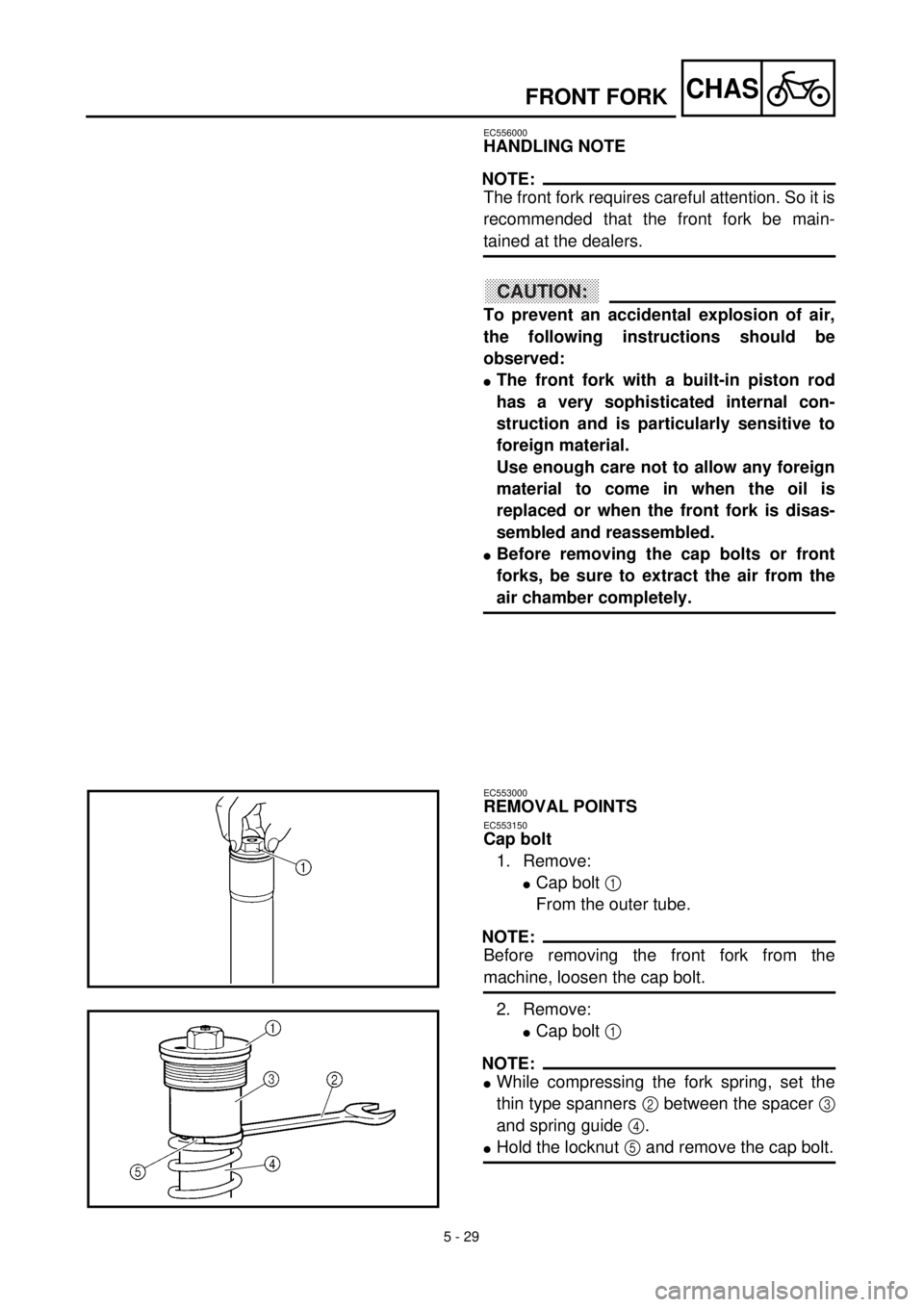Page 156 of 626
3 - 7
INSP
ADJ
RADIATOR CAP INSPECTION
CAUTION:
lDo not mix more than one type of ethyl-
ene glycol antifreeze containing corro-
sion inhibitors for aluminum engine.
lDo not use water containing impurities or
oil.
7. Install:
lRadiator cap
Start the engine and warm it up for a
several minutes.
8. Check:
lCoolant level
Coolant level low ® Add coolant. Handling notes of coolant:
The coolant is harmful so it should be han-
dled with special care.
WARNING
lWhen coolant splashes to your eye.
Thoroughly wash your eye with water
and see your doctor.
lWhen coolant splashes to your clothes.
Quickly wash it away with water and
then with soap.
lWhen coolant is swallowed.
Quickly make him vomit and take him
to a doctor.
EC355000
RADIATOR CAP INSPECTION
1. Inspect:
lSeal (radiator cap) 1
lValve and valve seat 2
Crack/damage ® Replace.
Exist fur deposits 3 ® Clean or
replace.
Page 170 of 626

3 - 14
INSP
ADJ
4. Inspect:
lOil level
Oil level should be between maximum
a and minimum b marks.
Oil level low ® Add oil to proper level.
NOTE:
When inspecting the oil level, do not screw the
oil level gauge into the oil tank.
Insert the gauge lightly.
(For USA and CDN)
CAUTION:
lDo not add any chemical additives.
Engine oil also lubricates the clutch and
additives could cause clutch slippage.
lDo not allow foreign material to enter the
crankcase.
(Except for USA and CDN)
CAUTION:
lDo not add any chemical additives or use
oils with a grade of CD a or higher.
lDo not use oils labeled “ENERGY CON-
SERVING II” b or higher. Engine oil also
lubricates the clutch and additives could
cause clutch slippage.
lDo not allow foreign materials to enter the
crankcase.
Recommended oil:
At 5 ˚C (40 ˚F) or higher
Yamalube 4 (20W-40) or SAE
20W-40 type SH motor oil
(Non-Friction modified)
At 15 ˚C (60 ˚F) or lower õ
Yamalube 4 (10W-30) or SAE
10W-30 type SH motor oil
(Non-Friction modified)
and/or
Yamalube 4-R (15W-50)
(Non-Friction modified)
Recommended oil:
Refer to the following chart for
selection of oils which are suited
to the atmospheric temperatures.
Recommended engine oil classi-
fication:
API STANDARD:
API “SH” or higher grade
(Designed primarily for motor-
cycles)-20
-4-10
140
3010
5020
6830
8640 50
104
122¡CTemp.
¡F
10W-30
10W-40
20W-40
20W-50
15W-40
a
b
ENGINE OIL LEVEL INSPECTION
Page 476 of 626

5 - 25
CHASFRONT BRAKE AND REAR BRAKE
2. Install:
lBrake hose holder 1
lScrew (brake hose holder) 2
ACHTUNG:CAUTION:
After installing the brake hose holders,
make sure the brake hose does not contact
the spring (rear shock absorber). If it does,
correct its twist.
Brake fluid
1. Fill:
lBrake fluid
Until the fluid level reaches “LOWER”
level line a.
WARNING
lUse only the designated quality brake
fluid:
otherwise, the rubber seals may deterio-
rate, causing leakage and poor brake per-
formance.
lRefill with the same type of brake fluid;
mixing fluids may result in a harmful chem-
ical reaction and lead to poor performance.
lBe careful that water does not enter the
master cylinder when refilling. Water will
significantly lower the boiling point of the
fluid and may result in vapor lock.
ACHTUNG:CAUTION:
Brake fluid may erode painted surfaces or
plastic parts. Always clean up spilled fluid
immediately.
Front
õRear
Recommended brake fluid:
DOT #4
T R..4 Nm (0.4 m · kg, 2.9 ft · lb)
õ
Page 484 of 626

5 - 29
CHASFRONT FORK
EC556000
HANDLING NOTE
NOTE:
The front fork requires careful attention. So it is
recommended that the front fork be main-
tained at the dealers.
ACHTUNG:CAUTION:
To prevent an accidental explosion of air,
the following instructions should be
observed:
lThe front fork with a built-in piston rod
has a very sophisticated internal con-
struction and is particularly sensitive to
foreign material.
Use enough care not to allow any foreign
material to come in when the oil is
replaced or when the front fork is disas-
sembled and reassembled.
lBefore removing the cap bolts or front
forks, be sure to extract the air from the
air chamber completely.
EC553000
REMOVAL POINTS
EC553150
Cap bolt
1. Remove:
lCap bolt 1
From the outer tube.
NOTE:
Before removing the front fork from the
machine, loosen the cap bolt.
2. Remove:
lCap bolt 1
NOTE:
lWhile compressing the fork spring, set the
thin type spanners 2 between the spacer 3
and spring guide 4.
lHold the locknut 5 and remove the cap bolt.
Page 544 of 626

5 - 59
CHAS
EC586000
HANDLING NOTE
WARNING
This shock absorber is provided with a
separate type tank filled with high-pressure
nitrogen gas. To prevent the danger of
explosion, read and understand the follow-
ing information before handling the shock
absorber.
The manufacturer can not be held respon-
sible for property damage or personal
injury that may result from improper han-
dling.
1. Never tamper or attempt to disassem-
ble the cylinder or the tank.
2. Never throw the shock absorber into
an open flame or other high heat. The
shock absorber may explode as a
result of nitrogen gas expansion and/
or damage to the hose.
3. Be careful not to damage any part of
the gas tank. A damaged gas tank will
impair the damping performance or
cause a malfunction.
4. Take care not to scratch the contact
surface of the piston rod with the cylin-
der; or oil could leak out.
5. Never attempt to remove the plug at
the bottom of the nitrogen gas tank. It
is very dangerous to remove the plug.
6. When scrapping the shock absorber,
follow the instructions on disposal.
EC587000
NOTES ON DISPOSAL (YAMAHA DEALERS
ONLY)
Before disposing the shock absorber, be sure
to extract the nitrogen gas from valve 1. Wear
eye protection to prevent eye damage from
escaping gas and/or metal chips.
WARNING
To dispose of a damaged or worn-out
shock absorber, take the unit to your
Yamaha dealer for this disposal procedure.
REAR SHOCK ABSORBER